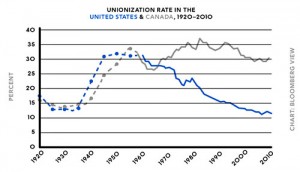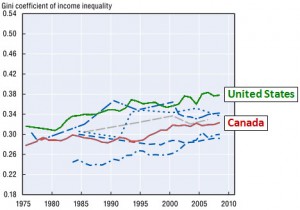What you need to know about Ohio Politics and Policy
Right To Work – a good way to increase inequality and lower wages
In mid December, Michigan became the 24th Right to Work state and the second state on Ohio’s border to enact such legislation (Indiana being the other). Michigan’s law was passed under questionable circumstances. The bill never received a committee hearing or any public discussion, then passed the legislature without a single Democratic vote, and was signed by the Republican Governor immediately. Since then, certain conservatives in Ohio have come out in support of a right to work initiative here in Ohio but key leaders like Gov. John Kasich have said this would not be the time for such an effort. Whether there is a movement to put a right to work initiative on the ballot sometime this year, or in 2014, inevitably Ohioans will start hearing about the horrors associated with having unions in Ohio. About how unions kill jobs, force businesses to relocate to other states, and are basically the scourge of the earth. While I at least look forward to systematically taking those arguments apart, today I want to focus on just a single issue: Union membership and income inequality. On Friday, Kevin Drum with Mother Jones magazine published a piece looking at the rate of union workers in the United States and in Canada and comparing the rate of income inequality in the United States and Canada. As you can see in the graph above, union membership in the United States is at an almost all-time low. Only about 11 percent of private sector employees are members of a union while in Canada that number is at over 30 percent and has been since the 1970’s. There are a variety of reasons for why this chart looks this way but the basic reason is that Canadian labor law is much more union-friendly than U.S. law. It is much easier for employees in Canada to start unions at their place of business while in American the process can be very bureaucratic and slow. This brings us to the next graph – a comparison of income inequality in the United States and in Canada. As you can see, while income inequality has increased in both countries the rate of inequality has been continually higher in the United States for many years. But considering that Canada and the United States have been forced to deal with the same globalization pressures why is the rate of income inequality in Canada not equal to what it is in America? One explanation may be because employees in Canada are much more likely to be a member of a union as compared to U.S. employees. Canadian union members would enjoy the benefits of union membership like higher wages, more benefits, and better job security. Compared to the United States, where only 11 percent of employees are members of unions, this leaves an ever growing portion of private employees without the power to negotiate with management for better benefits. This means lower wages, less benefits, and less job security for employees who are not union members. This is not just a single observation. Academic research has shown this to be the case as well. It has been documented that in right to work states wages are lower and benefits are more meager compared to states that allow employees to bargain with their employers. That’s why it would be irresponsible for lawmakers and politicians in Ohio to support a right to work effort. Any policy like right to work that would only cause income inequality in Ohio to grow should be roundly opposed. Especially at a time when policymakers need to be doing everything to ensure that growth is shared across all classes, not just those at the top. Follow me on Twitter at @BPeytonIOTagged in these Policy Areas:




